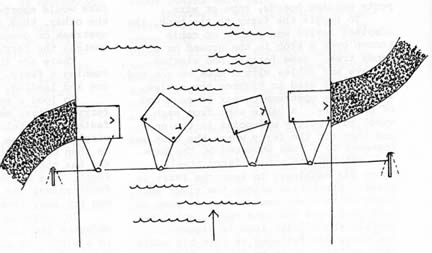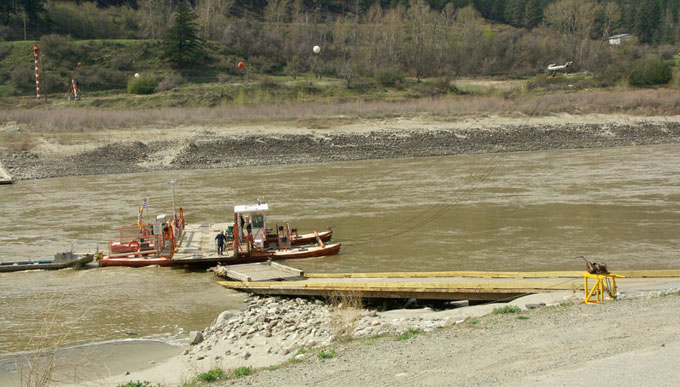Chapter 38: vis insita
“Particularly happy and better accomodated to our inquiry are the phenomena exhibited by the propulsion of boats. Imagine a cable or rope hanging high up across a river, suspended from both banks, and a pulley running along the rope, holding, by another rope, a skiff floating in the river. If the ferryman in the skiff, otherwise at rest, fastens his rudder or oar in the right manner, the skiff, carried crosswise by the simple force of the downward-moving river, is transported from one bank to the other, as the pulley runs along the cable above.” (p.405)
The type of cable ferry that Kepler is refering to is a current ferry or a reaction ferry, as opposed to a simple cable ferry which is drawn from one bank to another by actively pulling on the rope.

Here is a diagram, taken from a Springfield-Greene County Library website article about old-fashioned ferries in the Ozarks. The description given on that website for this diagram is as follows:
"The general principle of using the force of the current to cross the river is really quite simple. To cross the river, the ferryman turns the windlass, which in turn pulls the lines through the pulleys to point the ferry slightly upstream. Held by the big cable strung across the river so it can't go downstream with the current, the ferry is pushed across by the current. The force of the current, as it hits the oar board and goes over it and under the ferry, causes forward movement. When over halfway across the river, the ferryman turns the windlass to point the ferry toward the landing. Then, when the ferry is turned downstream to approach the landing, there is enough momentum left to glide gently into the bank. The lines and cable prevent overshooting the landing."
Here is an image of such a reaction ferry in Lytton, British Columbia. The ferry has two pontoons with a deck atop them. If you look towards the upper-right of the image, you can see the pulley that slides along the river. The pontoons can be independently pulled towards this pulley, letting the pontoon orientation be twisted, allowing them to act as Kepler's rudders. In this photo, the ferry is completing its motion towards the viewer's side of the river:

click for copyright info
| Next |  |
- References:
- Reaction Ferry article on Wikipedia
- A Ferry Tale article on the Ozarks